- Cancer Institute
- Cancer Research
- Cancer Registries
- Mississippi Cancer Registry
- Data and Statistics
- Lifestyle-Related Cancers
Lifestyle-Related Cancers
- Cancer Center and Research Institute
-
Cancer Research
- Cancer Research Overview
-
Cancer Registries
- Cancer Registries Home
- UMMC Cancer Registry
- Mississippi Cancer Registry
- Clinical Trials
- Programs
- For Students and Trainees
- Patient Support
- Give Now
- In the News
- Contact Cancer Center and Research Institute
- CCRI Leadership
Tobacco-related Cancers in Mississippi, 2003-2021
Smoking, exposure to second-hand smoke and use of other tobacco products are a modifiable risk factor associated with the development of certain cancers. According to the Behavioral Risk Factor Surveillance System for 2022, 17.4% of Mississippi adults report being current smokers, 22.7% report being former smokers and 4.3% of Mississippi adults report using smokeless tobacco. Mississippi’s rate of current smoking among adults is fifth highest in the nation, including the District of Columbia and Puerto Rico.1 Tobacco use is associated with cancers of the lip, oral cavity, pharynx, stomach, colon and rectum, pancreas, trachea, lung and bronchus, cervix, kidney and renal pelvis, urinary bladder, esophagus, liver and larynx. Tobacco use is also associated with the development of acute myeloid leukemia. Below are graphs of the trends in tobacco-related cancers over the period 2003 to 2021 by race and sex, with a description of the trends occurring in each group both for the full time period and for the most recent period between 2017 and 2021. All analysis was done using SEER*Stat software2.
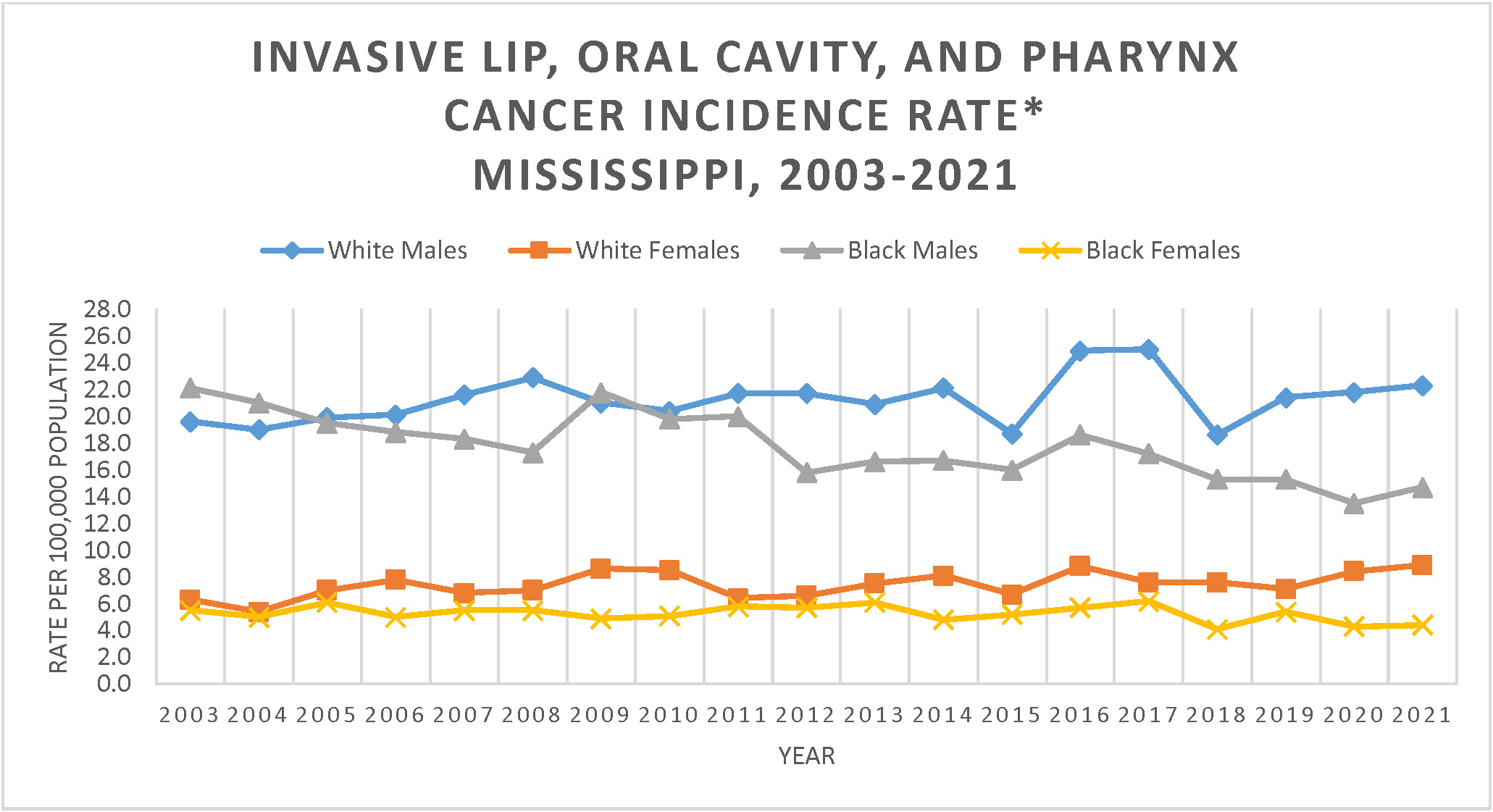
While lip, oral cavity and pharynx cancer is associated with tobacco use, it is also associated with another modifiable risk factor, alcohol use. Cancers of the oropharynx may also be associated with Human Papillomavirus (HPV) infection. Males had significantly higher rates of lip, oral cavity and pharynx cancers than females. Over the period from 2003 to 2021, only black males experienced a significant change in incidence rates. The rate for black males decreased annually by 2.02%. The rate for black females was also decreasing at an observed rate of 0.65%. The rates for white males and white females were observed to be increasing. The rate for white males increased at a rate of 0.58% annually and the rate for white females increased at a rate of 1.20% annually.
For the latest five-year time period of 2017 to 2021, black males, black females and white females had a similar trend to that of the overall time period of 2003 to 2021. Though not statistically significant, the rate for black males was decreasing at a rate of 4.27% annually and the rate for black females was decreasing at a rate of 7.09% annually. The rate for white females increased at an observed rate of 4.30% annually. White males had an opposite trend compared to the full time period of 2003 to 2021. Though not statistically significant, the rate for white males decreased at a rate of 1.24% annually.
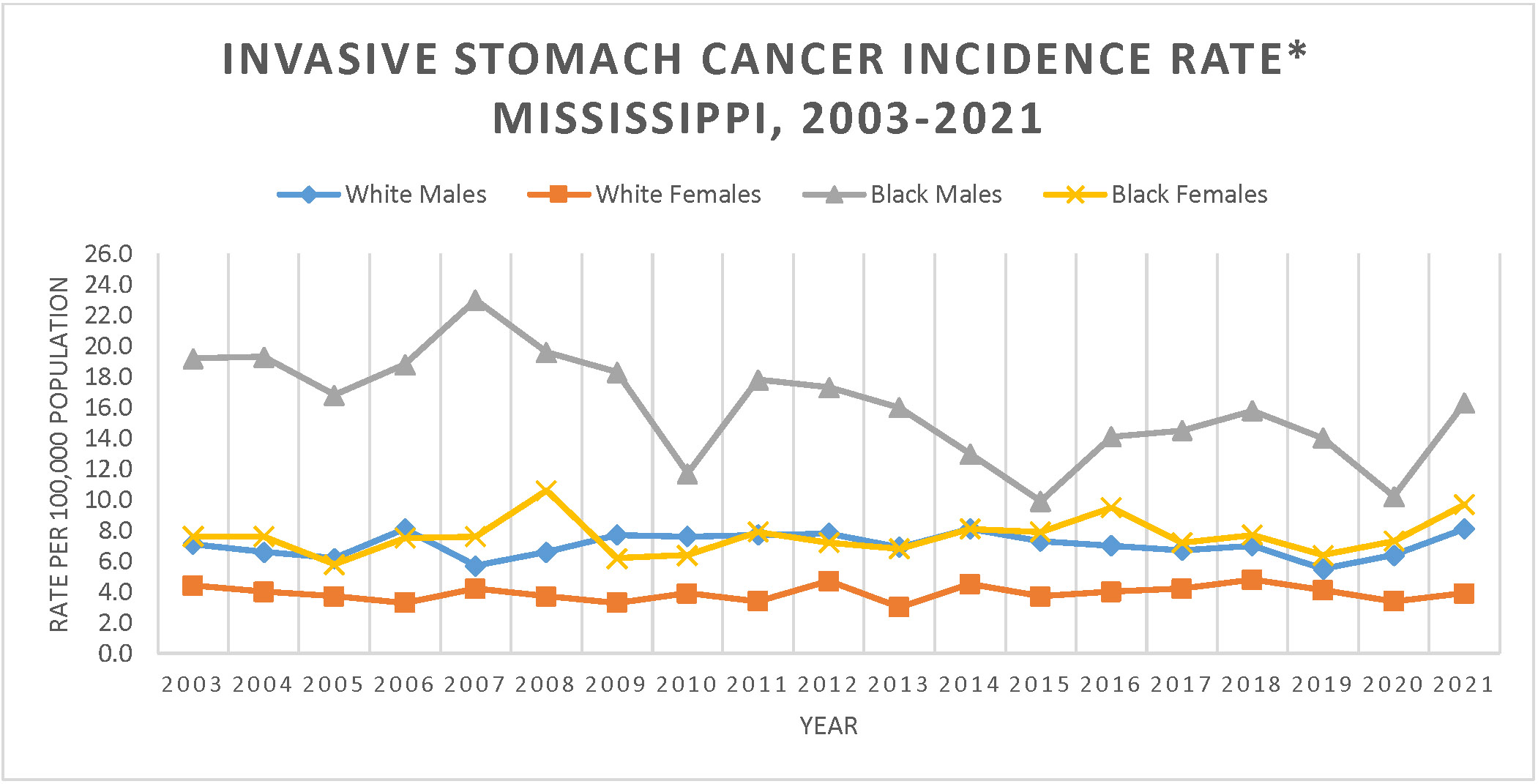
While all stomach cancers may be associated with tobacco use, cancers occurring in the gastric cardia (upper portion of the stomach next to the esophagus) may also be associated with obesity. Between 2003 and 2021, black males had significantly higher incidence rates for stomach cancer than all other groups except in 2015 and 2020. The rate for stomach cancer in black males decreased significantly between 2003 and 2021 at an annual percent change of 2.34%. No other group had any significant change over time. Black females had an observed increase of 0.50% annually between 2003 and 2021. White males had a stable rate over time and for white females, the observed change was a 0.36% annual increase.
For the latest five-year period from 2017 to 2021, none of the trends were statistically significant. Black males saw an observed annual decrease of 0.90%, while black females saw an observed increase of 6.31%. The annual increase for white males was 3.32% in contrast to the flat trend for the full time period. In contrast, white females had an observed annual decrease of 4.76%.
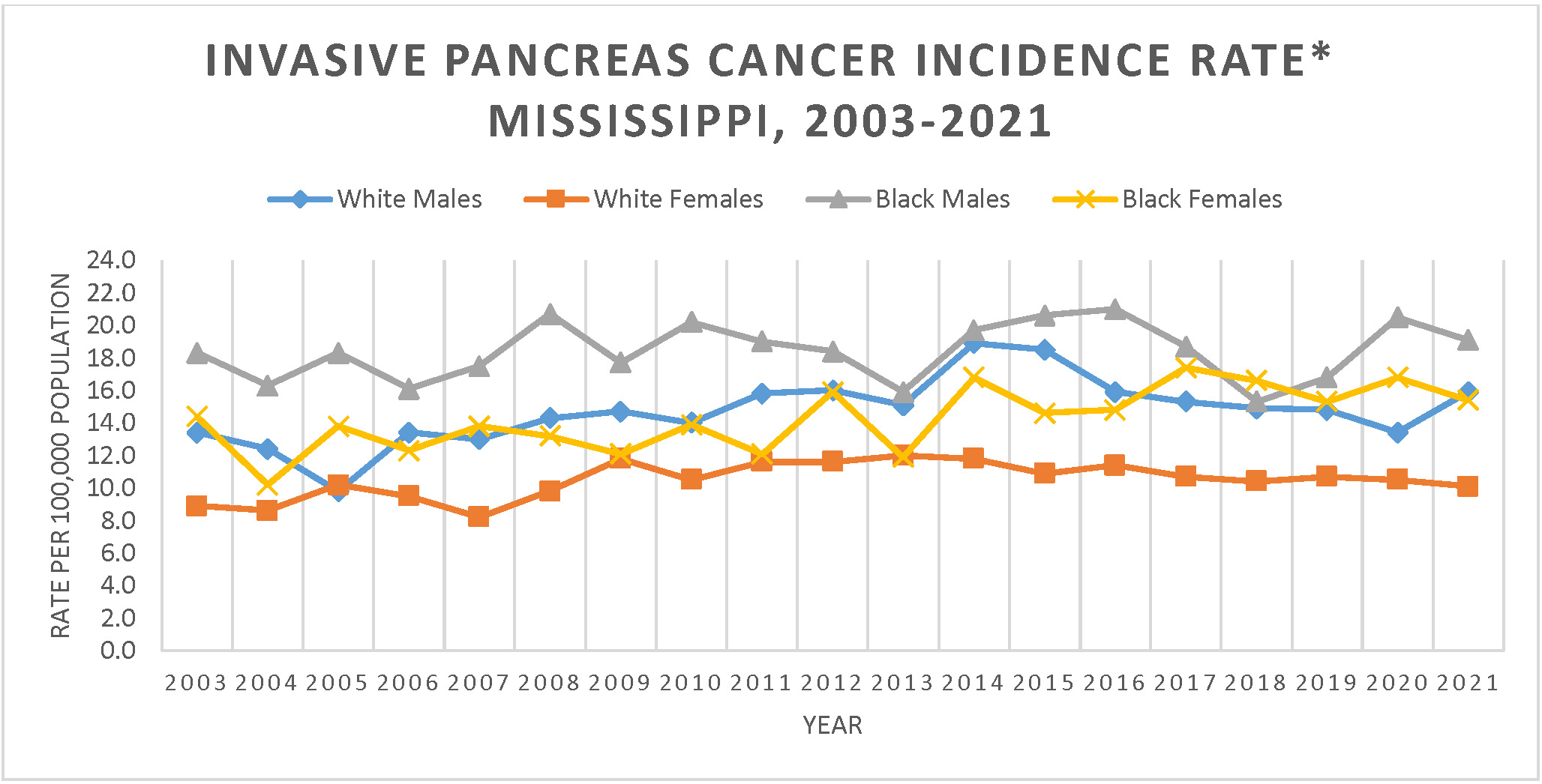
While pancreatic cancer is associated with tobacco use, it is also associated with another modifiable risk factor, obesity. ancreatic cancer rates increased significantly between 2003 and 2021 for females, overall. hite females experienced annual significant increase of 3.17% between 2003 and 2013 but then saw and observed 2.06% decrease between 2013 and 2021. verall, white females had an observed average annual increase of 0.8%. The rate for black females increased a significant 1.65% annually. or males, the average annual percent change between 2003 and 2021 was an observed increase of 0.90%. lack males had an observed increase of 0.33% annually. hite males experienced a significant increase between 2003 and 2014 of 3.60% annually but then experienced a significant decrease annually between 2015 and 2021 of 2.64%. his translates into a statistically significant average annual increase of 1.1% over the full time period.
For the latest five-year period of 2017-2021, the trends were decreasing for all groups except black males who saw an increasing trend. hite males had an observed decrease of 0.09% annually. or black males, the most recent trend observed is an increase of 3.18% annually and for black females the observed trend for the most recent five years was a 2.27% decrease annually. hite females had an observed annual decrease of 1.03%.
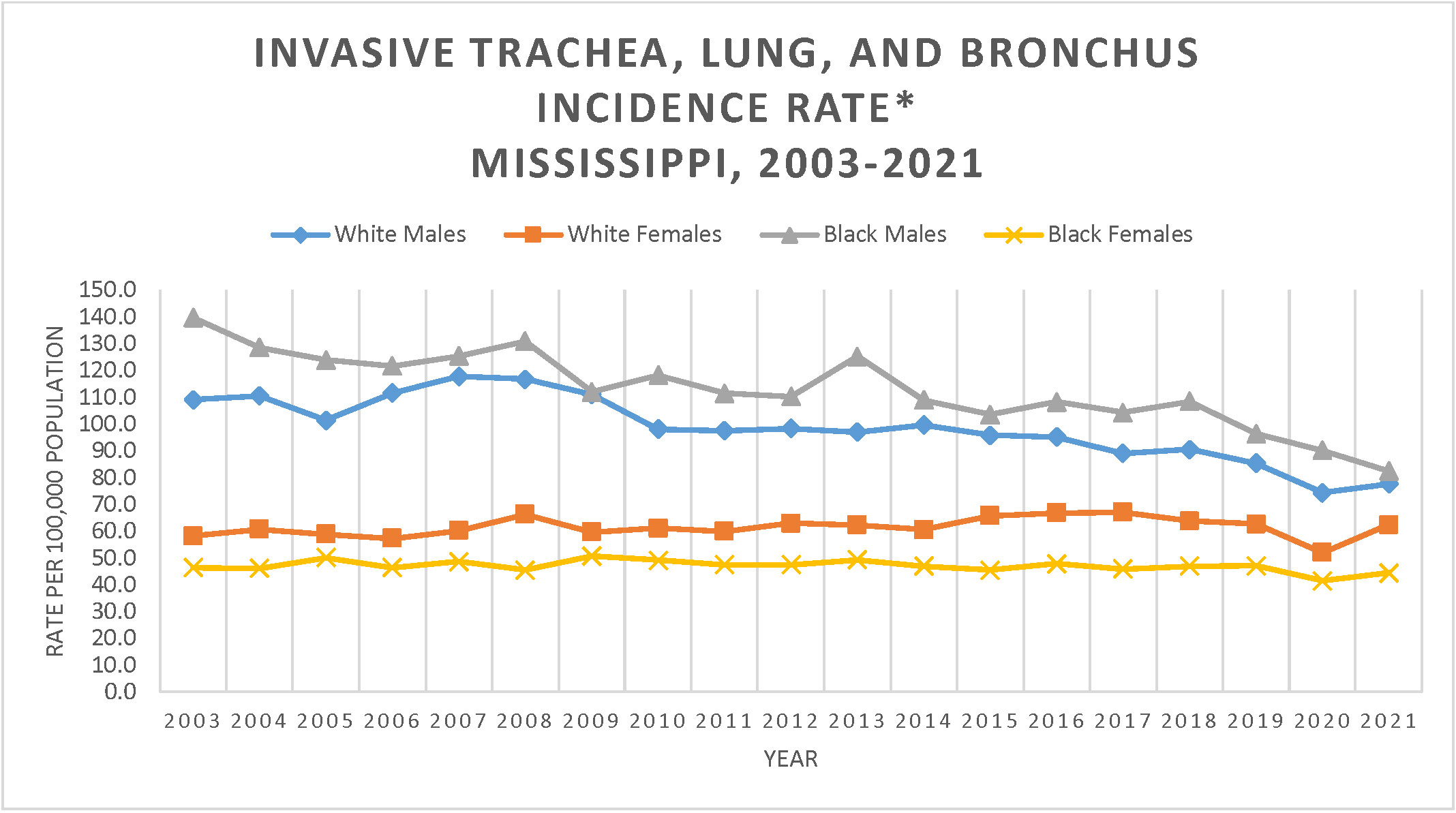
ales had significantly higher rates of trachea, lung and bronchus cancer than females. or most years, black males had significantly higher rates than white males. hite females had significantly higher incidence rates than black females. he rates for both white males and black males decreased at a significant average annual rate between 2003 and 2021. or white males, the rate increased 1.86% annually between 2003 and 2007. hen, between 2007 and 2021, the rated decreased significantly 2.56% annually. his translates to a significant average annual percent decrease of 1.60%. or black males, between 2003 and 2018, the rate decreased at an observed rate of 1.56%. hen, between 2018 and 2021, the rate decreased significantly at an annual rate of 7.41%. hus, the average annual percent decrease was a statistically significant 2.60%. lack females had no significant change in their rates with an annual decrease of 0.37%. or white females, between 2003 and 2017, the rate significantly increased 0.82% annually. hen, between 2017-2021, there was an observed decrease of 3.00% annually. his translated to a flat trend over the full time period.
Compared to the trends for the full time period from 2003 to 2021, white males, black males and black females had similar trends for the most recent five-year time period of 2017 to 2021. he rate for white males decreased significantly at a rate of 4.53% annually and the rate for black males decreased significantly at a rate of 6.34% annually. or black females, there was an observed decrease of 1.84% annually. or white females, instead of a flat trend, the rate for the latest five years is decreasing at an observed rate of 3.21%.
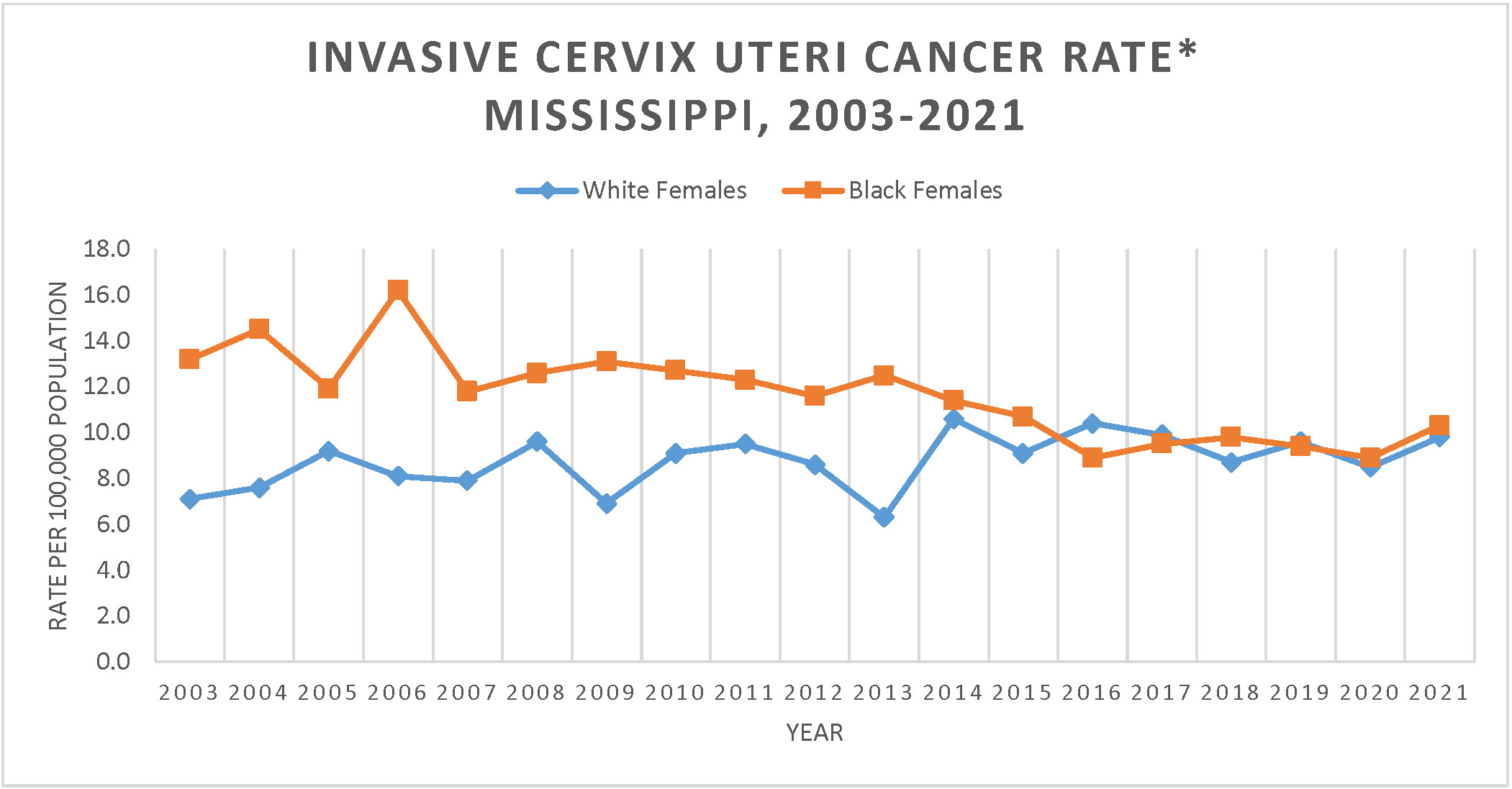
hile cervical cancer is associated with tobacco use, most cervical carcinomas are associated with Human Papilloma Virus (HPV) infection. For most years, there was not a statistically significant difference in the incidence rates of cervical cancer between white females and black females, though black females did have higher observed rates through 2015. uring the period between 2003 and 2021, the incidence rate for black females decreased at a significant rate of 248% annually. n contrast, the observed change in the incidence rate for white females was a 1.14% increase annually, though this change was not statistically significant. he incidence gap between black females and white females has been closed in the most recent years as a result of the significant decrease in rates for black females and the observed increase in rates for white females. etween 2017 and 2021, in contrast to the full time period, black females had an observed increase of 0.75% annually. he rate for white females decreased 0.41% annually between 2017 and 2021, though this change was not statistically significant.
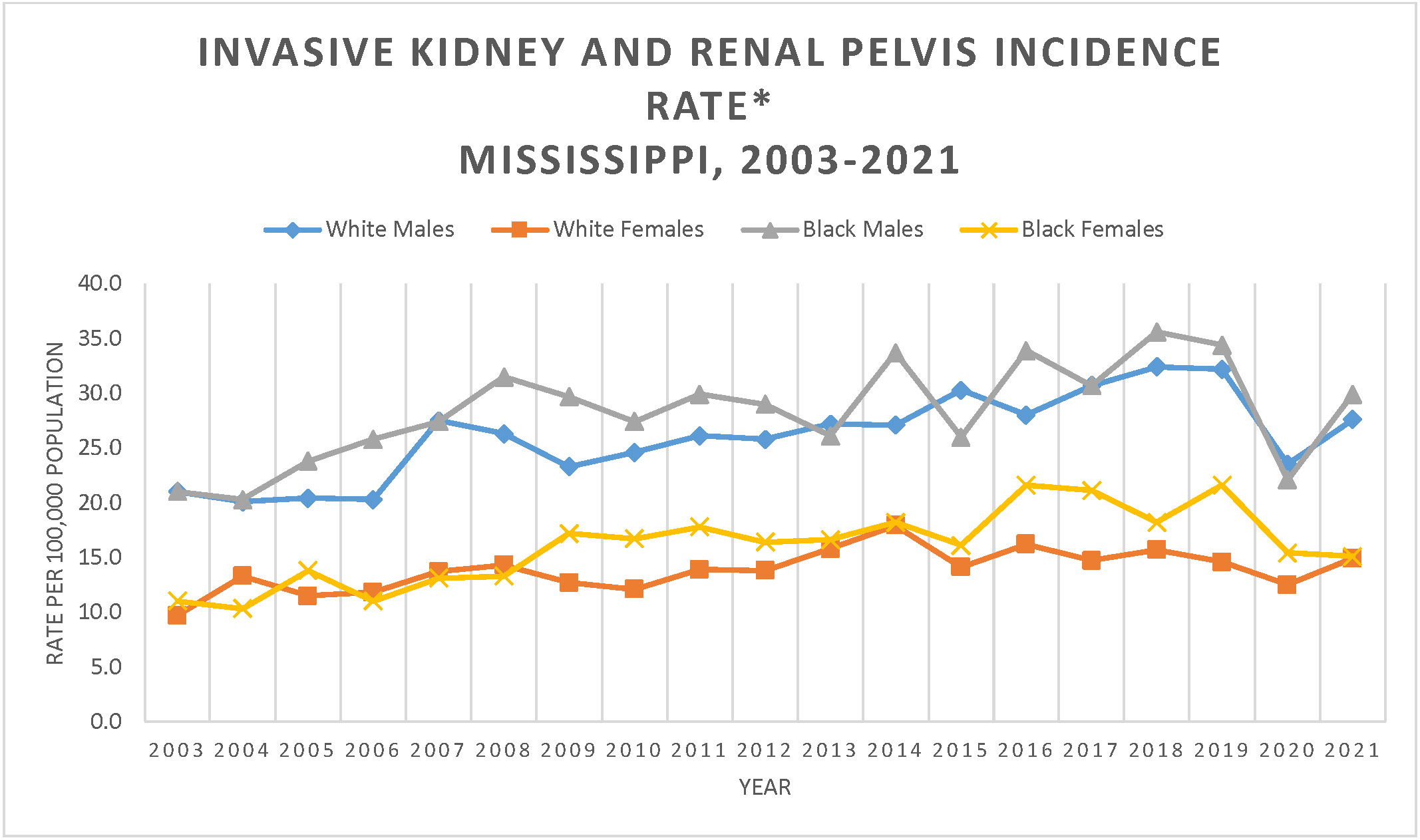
hile kidney and renal pelvis cancers are associated with tobacco use, kidney cancer is also associated with another modifiable risk factor, obesity. ales had significantly higher rates of kidney and renal pelvis cancer than females. he rates for males were similar over time. ates for females were similar for all years except 2009, 2010, 2016, 2017 and 2019 where black females had significantly higher incidence rates. ates for all groups increased between 2003 and 2021. ver the period from 2003 to 2018, rates for white males significantly increased annually at 2.88%. rom 2018 to 2021, the rate for white males was observed to decrease at a rate of 6.31% annually. his translates into a significant average annual change of 1.30% over the full time period. imilarly, the rates for white females increased significantly at a rate of 3.34% annually between 2003 and 2014. hen, between 2014 and 2021, the rate for white females was observed to decrease at a rate of 1.77% annually. his translates into an observed annual increase of 1.30% over the full time period. or black females, the incidence rate increased significantly at a rate of 3.83% annually between 2003 and 2019, followed by an observed annual decrease of 18.45% between 2019 and 2021. his translate to an observed annual increase of 1.10% for black females for the full time period. lack males had an observed increase of 1.46% annually.
For the latest five-year period of 2017 to 2021, white males, black males and black females all had observed annual increases. or white males, the annual increase was 2.55% and for black males, the observed annual increase was 4.83%. or black females, the observed annual increase was 3.00%. hite females had an observed annual decrease of 0.25%.
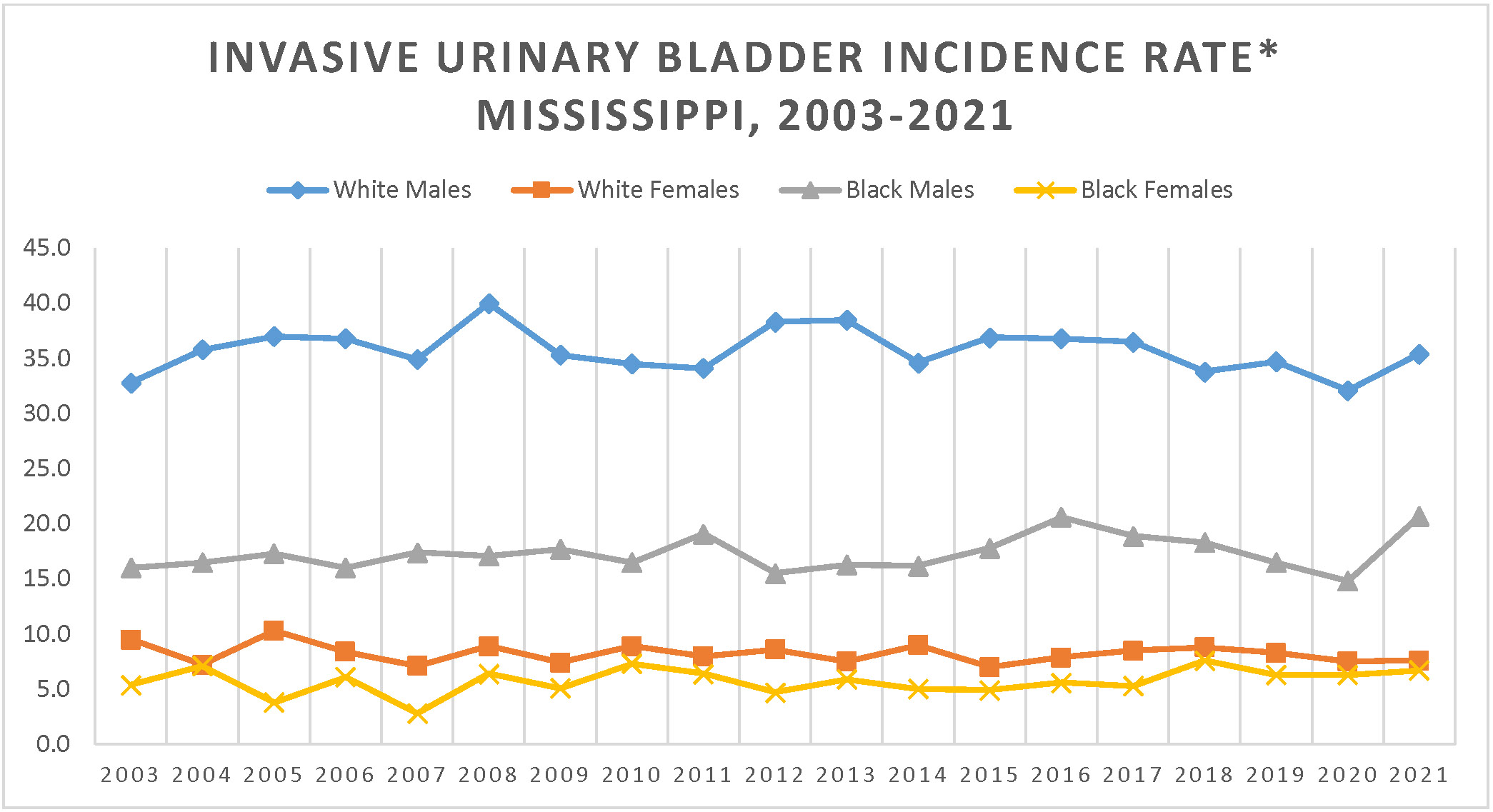
ales had significantly higher rates of urinary bladder cancer than females. lso, white males had significantly higher rates than black males. he observed annual percent change between 2003 and 2021 for all groups was relatively small. lack males had a 0.55% increase annually in their incidence rates and black females had a 0.93% increase annually. he other groups had observed decreases, though the decreases were small and not statistically significant. or white males, the decrease annually was only 0.22%. or white females, the annual decrease was 0.60%.
From 2017 to 2021, the patterns remained the same as for the full time period. hite males had an observed annual decrease of 1.07% and white females had an observed annual decrease of 3.73%. lack males had an observed annual increase of 0.22% and black females had an observed annual increase of 1.96%.
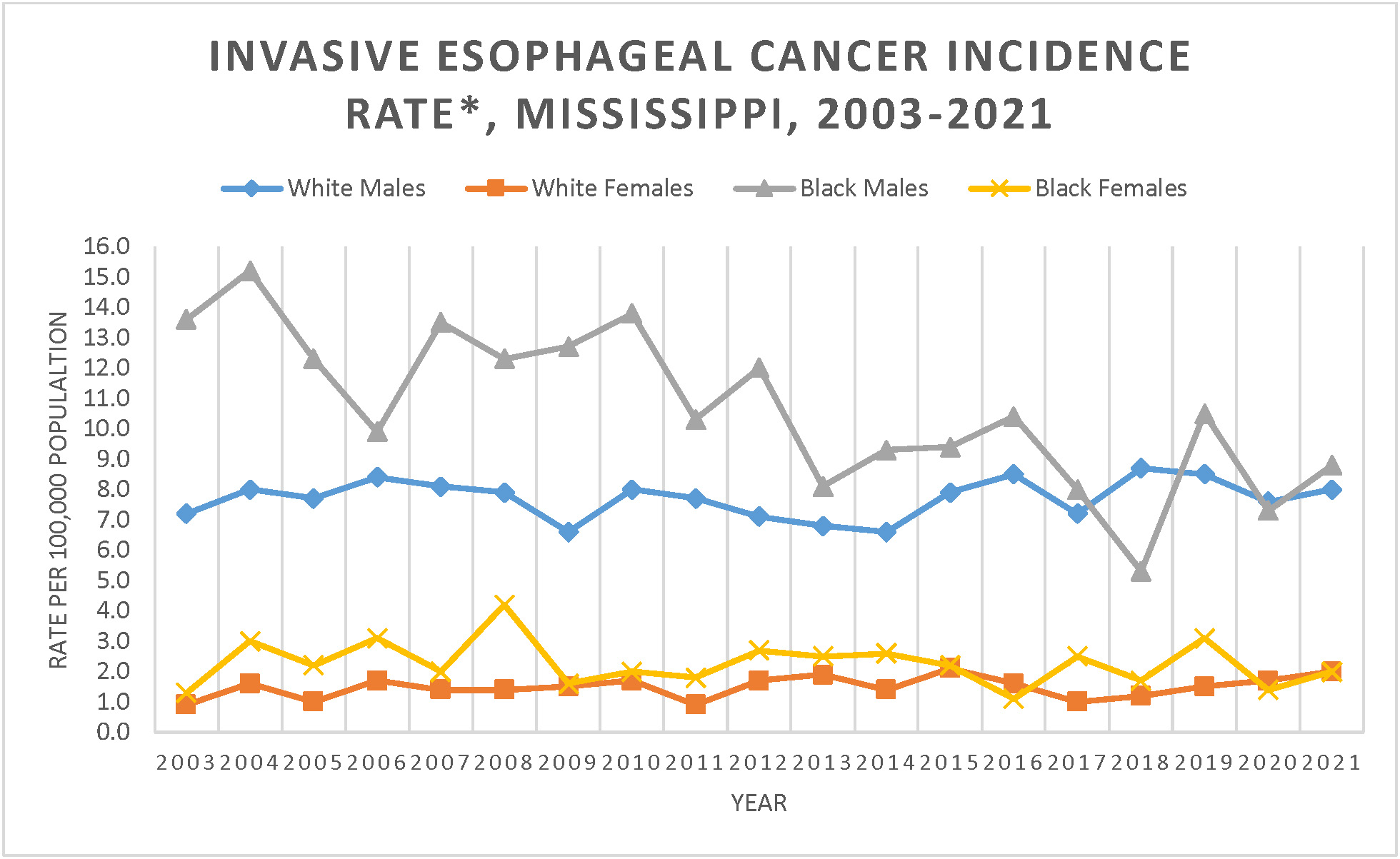
hile esophageal cancer is associated with tobacco use, it is also associated with another modifiable risk factor, alcohol use. dditionally, adenocarcinoma of the esophagus can be associated with obesity. ales had significantly higher rates of esophageal cancer than females. he rates were similar by race for females and similar for males beginning in 2013. he annual percent change over the period from 2003 to 2021 for black males and black females was statistically significant. or black males, the annual percent decrease was 3.27% and for black females was 1.52%. n contrast to black males and females, the rates for white males and white females increased, those the changes were not statistically significant. he rate for white females increased 1.36% annually and the rate for white males increased 0.24% annually.
For the latest five-year time period of 2017 to 2021, white males and black females had a similar trend to what was observed for the full time period of 2003 to 2021. he trend for 2017 to 2021 for white males was an annual increase of 0.51% and for black females was an annual decrease of 6.21%, neither of which were statistically significant. or black males, the trend for the most recent time period was opposite of the full time period from 2003 to 2021. or 2017-2021, black males experienced an observed increase of 4.50% annually. hite females, similar to the full time period, experienced an increasing trend, however the change was statistically significant. or 2017-2021, the rate for white females increased at a rate of 18.56% annually.
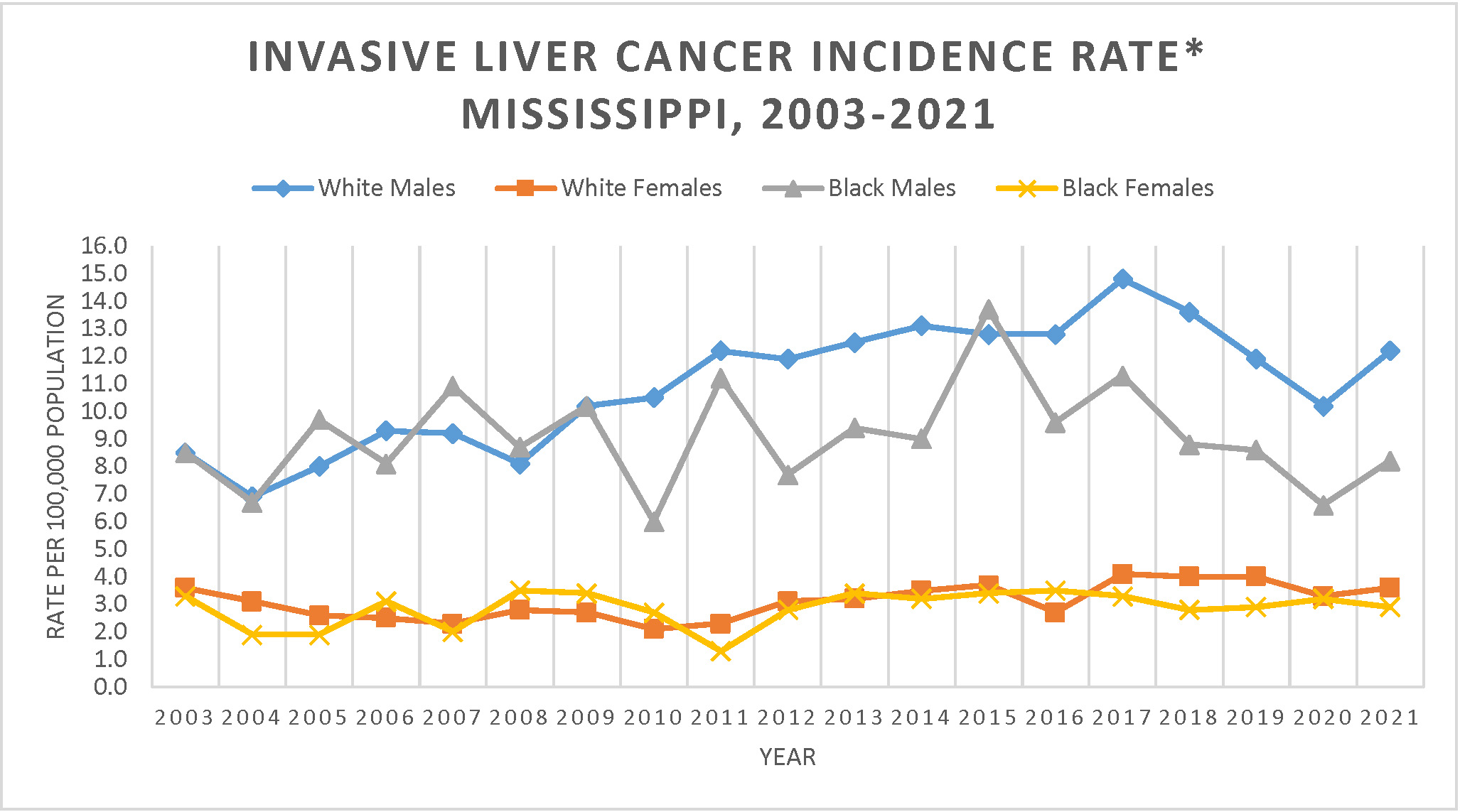
hile liver cancer is associated with tobacco use, it is also associated with two other modifiable risk factors, alcohol use and obesity. ike many of the other tobacco-related cancers, males had significantly higher rates of liver cancer than females. he rates were similar between the races for females and for males prior to 2012. eginning in 2012, white males had significantly higher rates that black males for many of those years. or white males, the incidence rate increased significantly between 2003 and 2017 at a rate of 4.58% annually. Between 2017 and 2021, the rate for white males decreased significantly at a rate of 6.65% annually. he rate for white females showed an annual decrease of 12.50% from 2003 to 2006, but then showed a significant increasing trend from 2006 to 2021 with an annual increase of 3.51%. he observed annual percent increase for black males was 0.10% and for black females was 1.19%.
For the latest five-year period of 2017 to 2021, trends were decreasing for all groups. or white males, the trend for the last five-year period was a decrease of 6.48% annually and for black males, the most recent trend observed was a decrease of 8.61% annually. or black females, the decrease was 1.47% annually and for white females, the decrease was 4.28% annually.
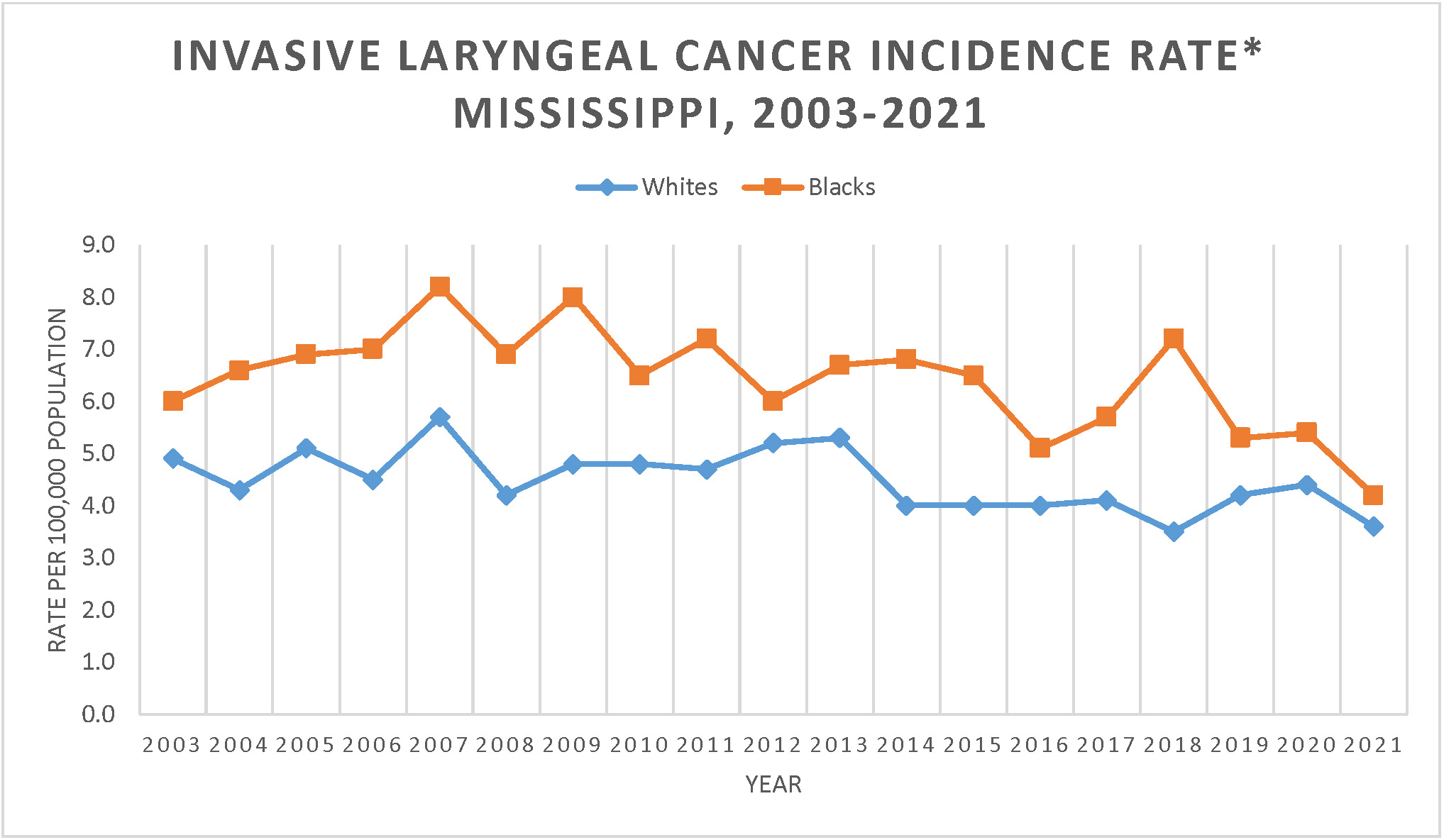
hile laryngeal cancer is associated with tobacco use, it is also associated with another modifiable risk factor, excessive alcohol use. aryngeal cancer is a relatively rare cancer. hus, the rates could not be broken down by both race and sex. his graph only displays the rates by race. ver the period from 2003 to 2021, the significant annual decrease for the white population was 1.42%. or the black population, between 2003 and 2007, there was an annual observed increase of 6.68%. etween 2007 and 2021, the black population experienced a statistically significant decrease of 2.91% annually. or the latest five-year time period of 2017 to 2021, the black population and white population saw decreasing trends. hese trends were not statistically significant. or the black population, the trend was an annual decrease of 8.52% and for the white population, the trend was an annual decrease of 0.05%.
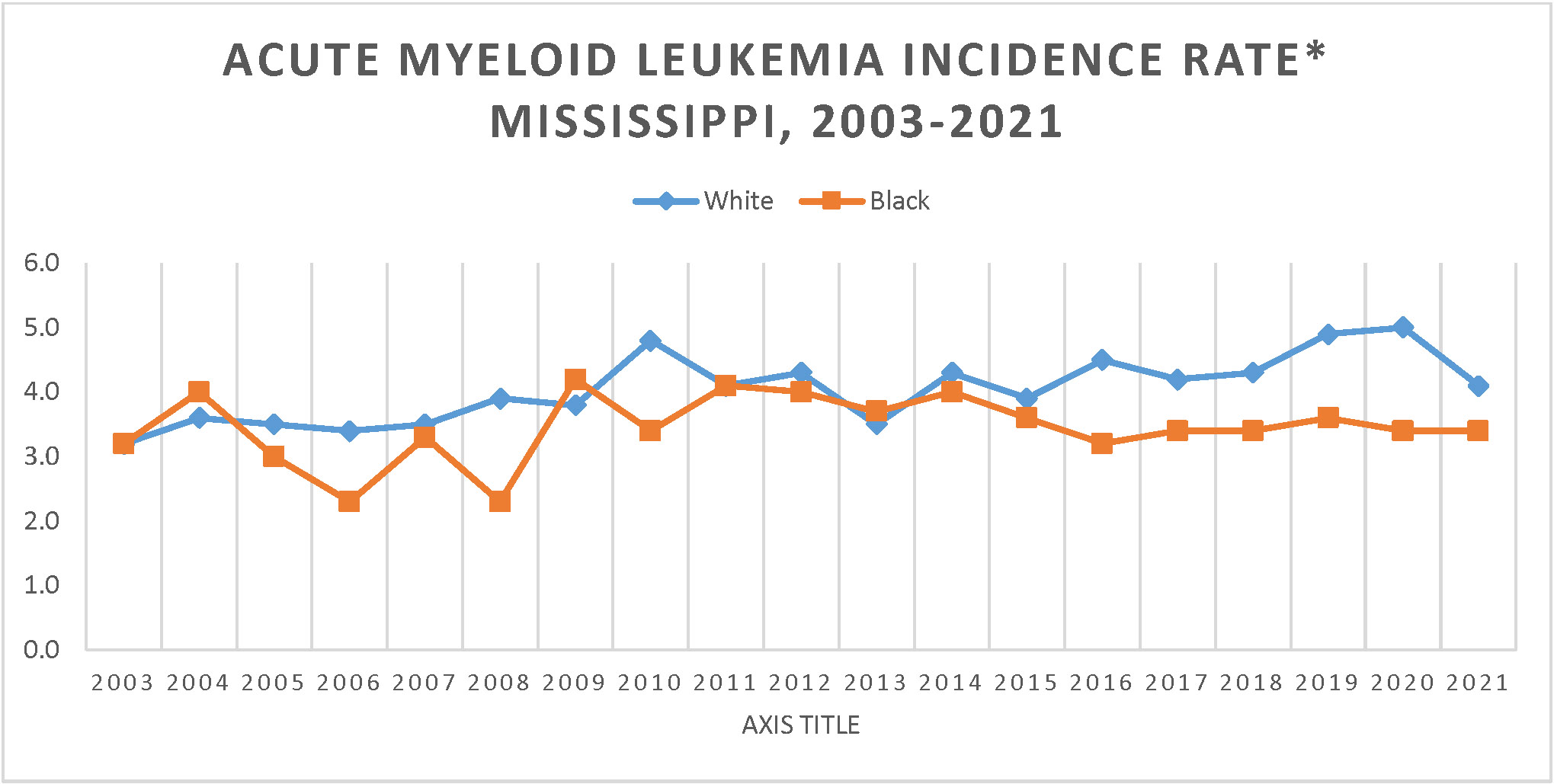
cute myeloid leukemia is a relatively rare type of cancer. ates over the period from 2003 to 2021 remained relatively stable for the black population with an observed annual increase of 0.44%. he white population saw a significant increase over this time period of 1.64% annually. he rates were similar between groups for most years.
For the latest five-year time period from 2017 to 2021, the trend for the white population was similar to the trend for the full time period from 2003 to 2021 but was not statistically significant. he white rate increased between 2017 and 2021 annually 1.05%. he rate for the black population was stable between 2017 and 2021.
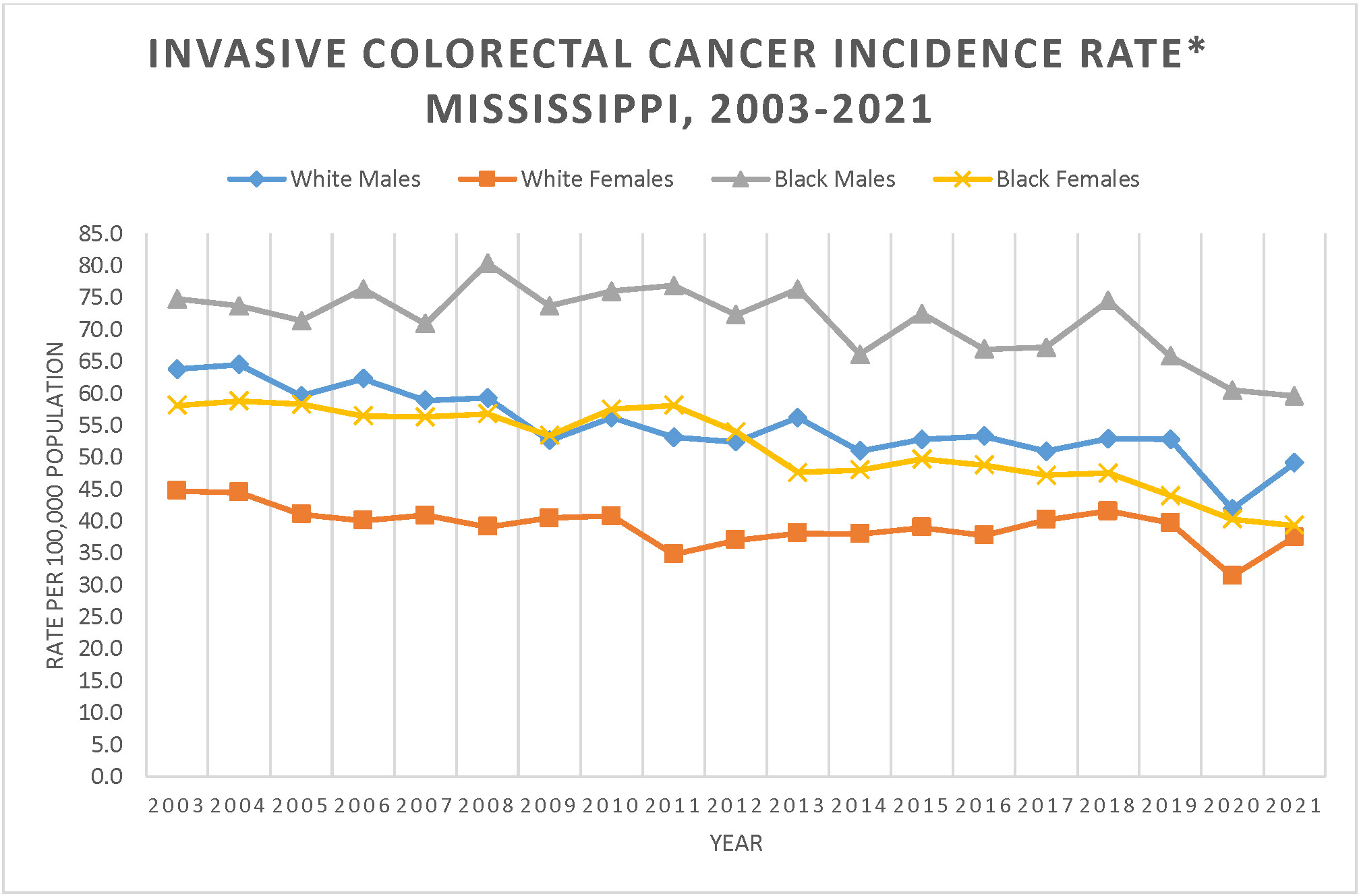
While colorectal cancer is associated with tobacco use, it is also associated with other modifiable risk factors, alcohol use (both colon and rectum cancers), obesity (both colon and rectum cancers) and lack of physical activity (only colon cancer). lack males had significantly higher rates of colorectal cancer than all other groups except for in years 2003 and 2004 where their rates were similar to those of white males. olorectal cancer rates decreased significantly in all groups except black males for the period between 2003 and 2021. hite females had a significant decrease of 0.79% annually and white males had a significant decrease of 1.53% annually. lack females experienced an annual observed decrease of 0.64% between 2003 and 2011, followed by a significant decrease annually of 3.04% between 2011 and 2021. hese patterns translate into a significant average annual percent decrease of 2.0% for black females over the full time period. etween 2003 and 2018, black males had an observed decrease of 0.51% annually. etween 2018 and 2021, black males experienced a significant decrease of 6.01% annually. hese patterns translate into an observed average annual decrease of 1.4% for black males over the full time period.
For the latest five-year period of 2017 to 2021, all groups experienced an observed decrease, but only black females experienced a significant decrease. lack females had a significant annual decrease of 5.18%. or black males, the observed annual rate of decrease was 4.47%. hite females had an observed annual decrease of 3.775 and white males had an observed annual decrease of 2.82%.
Definitions
Age Adjusting: statistical method that allows comparisons of populations that take into account age-distribution differences between the populations. he 2000 U.S. standard population is used and applied to all of the time periods being considered. his assures that the rates do not reflect differences in the age distribution of the population.
Annual Percent Change (APC): he average annual percent change over several years. t is used to measure the change in rates over time. alculating the APC involves fitting a straight line to the natural logarithm of the data when it is displayed by calendar year.
Statistical Significance: his is a mathematical measure of the difference between groups. difference is said to be statistically significant if it is greater than what might be expected to happen by chance alone 95% of the time. ate ratios were used to assess the statistical significance between groups.
Citations
1Centers for Disease Control and Prevention, National Center for Chronic Disease Prevention and Health Promotion, Division of Population Health. BRFSS Prevalence & Trends Data [online]. 2022. [accessed Jun 3, 2024]. URL: https://www.cdc.gov/brfss/brfssprevalence/index.html.
2Surveillance Research Program, National Cancer Institute SEER*Stat software (seer.cancer.gov/seerstat) version 8.4.3.
Acknowledgement
We acknowledge the Centers for Disease Control and Prevention for their financial support under a cooperative agreement awarded to the Mississippi Cancer Registry.


